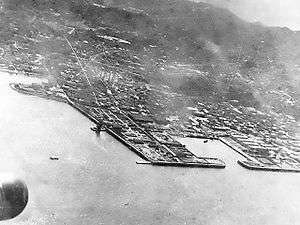Yokosuka Naval District

Yokosuka Naval District (横須賀鎮守府 Yokosuka chinjufu) was the first of four main administrative districts of the pre-war Imperial Japanese Navy. Its territory included Tokyo Bay and the Pacific coasts of central and northern Honshū from the Kii Peninsula to Shimokita Peninsula. Its headquarters, along with most of its installations, including the Yokosuka Naval Arsenal, were located in the city of Yokosuka, which constituted the Yokosuka Naval Base.
The location of Yokosuka at the entrance to strategic Tokyo Bay was recognized of critical importance by the Tokugawa shogunate and early Meiji government. In 1866, the Tokugawa shogunate government established the Yokosuka Seisakusho, a military arsenal and naval base, with the help of foreign engineers, including the French naval architect Léonce Verny. The new facility was intended to produce modern, western-style warships and equipment for the Tokugawa navy. After the Boshin War and the Meiji Restoration, the new Meiji government took over control of the facility in 1871, renaming it the Yokosuka Zosenjo (Yokosuka Shipyards). In August 1876, the Imperial Japanese Navy was organized into eastern and a western strategic zones, with the eastern zone Tōkai chinjufu (東海鎮守府) based at Yokosuka, and the western zone Saikai chinjufu (西海鎮守府) based at Nagasaki. However, for ease of communications with naval headquarters in Tokyo, the Tōkai Naval District was relocated to Yokohama in September 1876.
With the reorganization of the Imperial Japanese Navy in April 1886, Japan was divided into five naval districts for recruiting and supply, and the headquarters for the Tokai Naval District was relocated back to Yokosuka, becoming the Yokosuka Naval District, and the Yokosuka Naval Arsenal was placed under its command. As with all naval districts, it was under the direction of the Navy Ministry during peacetime, and came under the command of the fleets stationed within the district in time of war.[1] A Bureau of Torpedo Warfare was established at Yokusuka in June 1885. In a further administrative re-organization of the Japanese Navy in 1889, Yokosuka was designated as the “First Naval District” (第一海軍区 dai-ichi kaigunku), and its harbor was dredged, a breakwater extended and docking facilities for warships were increased. A Bureau of Mine Warfare was also established. In 1893, schools for naval mechanical engineering, torpedo warfare and naval artillery were established. Schools for naval engineering, and for mine warfare followed in 1907 and a naval medical center in 1908. Naval aviation facilities were established in June 1912, followed by a wireless communications facility in April 1913.
On January 14, 1917, the armoured cruiser Tsukuba exploded and sank in Yokosuka port in an accident. The Naval Construction Department was established in 1921. In June 1930, a Naval Communications School was established, but the Naval Mine School was made independent of the naval district. A Naval Aviation School was established in April 1934.
At the time of the attack on Pearl Harbor in 1941, Yokosuka Naval District encompassed the following [2]
- Yokosuka Naval District HQ
- Yokosuka Naval Base
- Yokosuka Naval Base HQ
- Yokosuka Communications Center
- Yokosuka Supply Department
- Accounting Department
- Construction Department
- Ports & Docks Unit
- Yokosuka Naval Arsenal
- Naval Hospital
- Naval Prison
- Naval Fuel Depot
- Yokosuka Base Garrison
- Yokosuka 1st Naval Barracks[3]
- Yokosuka 2nd Naval Barracks[3]
- Yokosuka Special Naval Landing Forces
- Yokosuka Submarine Base
- Yokosuka Security Squadron[3]
- Auxiliary Cruiser Noshiro Maru, Auxiliary gunboat Shoei Maru, Meiji Maru No. 1
- Yokosuka Local Defence Squadron[3]
- Minesweeper Division 25; Auxiliary minesweeper Misago Maru No. 1, Misago Maru No. 3, Kongo Maru No. 2, Naruo Maru, Shintohoku Maru, Togo Maru
- Minesweeper Division 26; Auxiliary minesweeper Banshu Maru No. 18, Keijin Maru No. 1, Keijin Maru No. 2, Showa Maru No. 10,
- Submarine tender Komahashi[3]
- Destroyer Sawakaze, Yugumo[3]
- Submarine Chaser No. 22, No. 23[3]
- Yokosuka Naval Air Group (Oppama)
- Tateyama Naval Air Group
- Kisarazu Naval Air Group
- 11th Combined Air Group (Training)
- Kasumigaura Naval Air Group
- Tsukuba Naval Air Group
- Yatabe Naval Air Group
- Hyakurihara Naval Air Group (Ibaraki Pref)
- Kashima Naval Air Group
- Suzuka Naval Air Group
- Tsuchiura Naval Air Group
- Yokosuka Naval Base
Yokosuka was bombed by United States Navy and United States Army Air Forces aircraft in the final stages of the Pacific War, most notably during the attack on Yokosuka on 18 July 1945, but many of its facilities were captured intact by the Allied forces. The Yokosuka area came under occupation by American forces during the occupation of Japan, and most of the facilities of the former Yokosuka Naval District were inherited by the United States 7th Fleet and are now known as United States Fleet Activities Yokosuka. A small portion of the area continues to be used by the modern post-war Japanese Maritime Self-Defense Force, which has preserved a portion of the original red brick gates.
References
- Notes
- Bibliography
- Evans, David (1979). Kaigun: Strategy, Tactics, and Technology in the Imperial Japanese Navy, 1887-1941. Annapolis, MD: US Naval Institute Press. ISBN 0-87021-192-7.
- Prados, John (1995). Combined Fleet Decoded: The Secret History of American Intelligence and the Japanese Navy in World War II. Annapolis, MD: US Naval Institute Press. ISBN 0-460-02474-4.
- Senshi Sōsho Vol. 80, Combined Fleet #2, "Until June 1942", Asagumo Simbun (Tokyo, Japan), 1975.